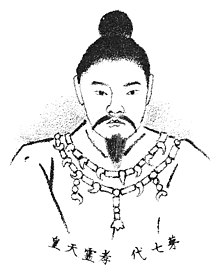Kōrei

Kōrei ( Japanese 孝 霊 天皇 , Kōrei-tennō ; * 342 BC ; † 215 BC ) was the 7th Tenno of Japan (290 BC – 215 BC ) according to the ancient chronicles of Kojiki and Nihonshoki . Chr.). Its historical existence is doubtful. He is one of the "eight undocumented emperors" ( 欠 史 八 代kesshi hachidai ) of whom only a sketchy representation is known.
His proper name was Ō-yamato-neko-hiko-futo-ni no mikoto (Nihonshoki: 大 日本 根子 彦 太 瓊 尊 , Kojiki: 大 倭 根子 日子 賦 斗 邇 命 ). According to the Nihonshoki, his mother was Oshi-hime ( 押 媛 ), according to the Kojiki Oshika-hime no mikoto ( 忍 鹿 比 売 命 ). On the 5th day of the 1st lunar month in the 76th year of his father Kōan's reign (317 BC) , he was appointed Crown Prince at the age of 26 and took over after his death on the 12th day of the 1st lunar month of the following year (290 BC) . Chr.) The throne.
Kōan ruled in the palace Iodo ( 黒 田 廬 戸 宮 Kuroda no Iodo no miya ) in Kuroda (today probably Tawaramoto ). His wives and children were (named in Nihonshoki and Kojiki, separated by a slash):
- Hoso-hime no mikoto ( 細 媛 命 / 細 比 売 命 , also read Kuwashi-hime), wife
- Ō-yamato-neko-hiko-kuni-kuru no mikoto ( 大 日本 根子 彦 国 牽 尊 / 大 倭 根子 日子 国 玖 琉 命 ), son
- - / Kasuga-no-chichi-haya-ma-waka-hime ( 春日 之 千千 速 真 若 比 売 ), concubine. Is not listed in the Nihonshoki, which however mentions that Hoso-hime, according to a source, was identical to Kasuga-no-chichi-haya-yama-ka-hime ( 春日 千 乳 早 山 香 媛 ).
- - / Chichi-haya-hime no mikoto ( 千千 速比 売 命 ), daughter
- Yamato-no-kunika-hime ( 倭国 香 媛 ) or Hae-irone ( 絙 某 姉 ) / Ō-yamato-kuni-are-hime no mikoto ( 意 富 夜 麻 登 玖 邇 阿 礼 比 売 命 ), concubine
- Yamato-toto-hi-momo-so-hime no mikoto ( 倭 迹 迹 日 百 襲 姫 命 ) / Yamato-to-momo-so-hime no mikoto ( 夜 麻 登登 母 母 曾 毘 売 命 ), daughter
- - / Hiko-sashi-kata-wake no mikoto ( 日子 刺 肩 別 命 ), son
- Hiko-i-saseri no mikoto ( 彦 五十 狭 芹 彦 命 ) or Kibi-tsu-hiko no mikoto ( 吉 備 津 彦 命 ) / Hiko-isa-seri-biko no mikoto ( 比古伊佐 勢 理 毘 古 命 ) or Ō -kibi-tsu-hiko no mikoto ( 大吉 備 津 日子 命 ), son
- Yamato-toto-waka-ya-hime no mikoto ( 倭 迹 迹 稚 屋 姫 命 ) / Yamato-tobi-haya-waka-ya-hime ( 倭 飛羽 矢 若 屋 比 売 ), daughter
- Hae-irodo ( 絙 某 弟 / 蠅 伊呂 杼 ), concubine
- Hiko-sashima no mikoto ( 彦 狭 嶋 命 ) / Hiko-same-ma no mikoto ( 日子 寤 間 命 ), son
- Waka-take-hiko no mikoto ( 稚 武 彦 命 ) / Waka-hiko-take-kibi-tsu-hiko no mikoto ( 若 日子 建 吉 備 津 日子 命 ), son
According to the Nihonshoki, he died at the age of 128 on the 8th day of the 2nd lunar month in his 76th year of reign (215 BC), after the Kojiki at the age of 106. His mausoleum ( misasagi ) is the tumulus Takaoka-no-umasaka-no-misasagi ( 片 丘馬 坂 陵 ; 34 ° 35 ′ 23 ″ N , 135 ° 42 ′ 6 ″ E ) in Ōji . His successor was Ō-yamato-neko-hiko-futo-ni.
The name Kōrei, whose characters mean ' filial piety ' and 'spirit, soul', was given later when the Japanese emperors began to give themselves Chinese, often Buddhist-inspired names.
Individual evidence
- ^ A b c d William George Aston: Nihongi: Chronicles of Japan from the Earliest Times to AD 697 . Trench, Trübner & Co., London 1896, p. 146–147 ( Textarchiv - Internet Archive ). ; Copy of Nihonshoki (Japanese)
- ↑ a b c d Basil Hall Chamberlain: The Kojiki . 1919, Section LX. - Emperor Kō-rei ( sacred-texts.com ).
- ↑ 天 皇陵 - 孝 靈 天皇 片 丘馬 坂 陵 . Kunai-chō , accessed October 6, 2017 (Japanese).
| predecessor | Office | successor |
|---|---|---|
| Koan |
Tennō 290–215 BC Chr. |
Kōgen |
| personal data | |
|---|---|
| SURNAME | Kōrei |
| ALTERNATIVE NAMES | Kôrei; 孝 霊 天皇 (Japanese) |
| BRIEF DESCRIPTION | 7. Tennō of Japan (290 BC – 215 BC) |
| DATE OF BIRTH | 342 BC Chr. |
| DATE OF DEATH | 215 BC Chr. |
